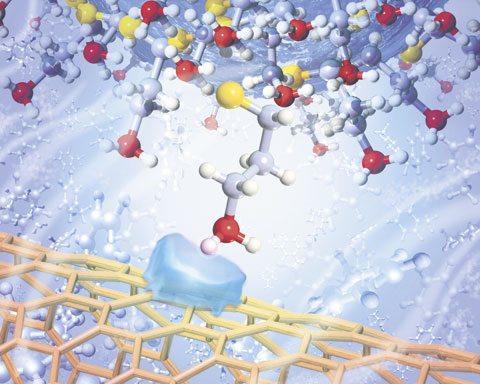What impact will nanotechnology have on our lifestyles and health in 2030? In a fictional lawsuit, two scientists look into the future.
“People of the jury, it’s hard to imagine, but twenty years ago people used so-called windscreen wipers to clear water drops off the windscreens of their cars. They didn’t have water-repellent glass. And they had energy problems and food that decayed. Now we just add nanoparticles to the food to conserve it, and for our energy needs we mimic photosynthesis.”
The year is 2030 and the location is a courtroom in Science Centre Nemo in Amsterdam. Nanotechnologist professor Dave Blank, of the Institute for Nanotechnology Mesa+ (University of Twente), just took the stand to defend a decision the Dutch government took twenty years earlier to invest heavily in nanotechnology research.
Blank’s opponent in this remarkable setting is a toxicologist, professor Paul Borm, of Zuyd University (province of Limburg), who is acting as the prosecutor. According to prof. Borm, who was a member of the Dutch Health Council committee on health issues of nanomaterials, nanotechnology leads to blunders like clean air paint that removes harmful fine particles from the air but also turns out to poison our drinking water, or the self-cleansing, nanocoated roof tiles that react with oxygen and produce ozone.
Playful as the event might seem, it was also deadly serious. Over the course of the coming four years, NanoNed, a consortium of seven universities (including TU Delft), TNO and Philips, will spend hundreds of millions on nanotechnological research (talks are of approximately 300 million euros, as was spent over the previous four years). Government, research institutes and private companies all share in the costs. A new stipulation for this wave of funding however is that fifteen percent of the government’s money must be spent on risk research and impacts on society.
That doesn’t reassure prof. Borm. He says that standard toxicological research falls short when nanoparticles are in play. Normally, when new chemicals are tested, they are exposed to animals in increasing doses to determine if they have harmful effects. But nanoparticles come in innumerable forms.
Take carbon nanotubes for instance; not only do they vary in length and diameter but also in the number of walls they are made of. Due to their design, some tubes might be carcinogenic while others are not.
The ‘prosecutor’ believes that scientists need to come up with a categorisation system, in which nanoparticles are divided into classes based on their design: “But I haven’t seen any research proposals that are aimed at this.”
Such a categorisation system already exists for micro particles, like fibres. Asbestos is an example of a group of fibres that is dangerous. But asbestos is not alone: many fibres that have the same length to diameter ratio are also carcinogens. Borm:”We have to find rules of thumb like these for nanoparticles.”
Borm says that some projects should be ‘enclosed with barbed wire’ until more is known about the way particles act. In prof. Blank’s future scenario, people are treated with glowing nanoparticles that head straight to the tumour after being injected in the bloodstream, thereby facilitating an operation. Yet the effects of such particles are not well known. Prof. Borm would rather prevent any harm caused by such particles and appeals for the slow development of a conceptual understanding of how nanoparticles act in the body before they are used.
“I surely won’t trivialise the potential dangers of nanoparticles”, argues Blank, who is one of the authors of the 300-million euro research proposal. “But”, he elaborates, “sometimes it’s up to a doctor to decide whether it’s worth it to use particles that might also have negative effects that are not yet known.”
Prof. Blank doesn’t believe too little is being done to arrive at a categorisation system: “What people don’t realise is that nanotechnology is not aimed at producing nanoparticles, but rather is all about developing tools to study particles. So research on new technologies and insights into dangerous particles go hand in hand.”
After hearing the verdict of the jury – which consisted of a few dozen day trippers – the judge orders that instructions should be sent out in a time capsule to the scientific community of the year 2010, ordering the organisation of more debates about nanotechnology.
Toen agenten gingen kijken, bleek dat één van de appartementen zo vol stond met mensen dat de politie de veiligheid van bezoekers niet kon garanderen.
Ook het portiek stond vol met mensen zodat een eventuele vluchtweg niet bereikbaar was. De politie besloot het feest te beëindigen en stuurde de bezoekers naar huis.



Comments are closed.